

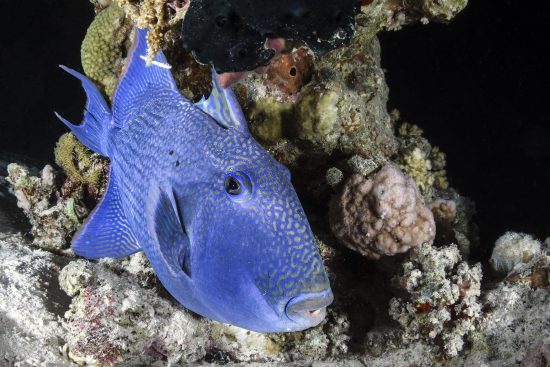
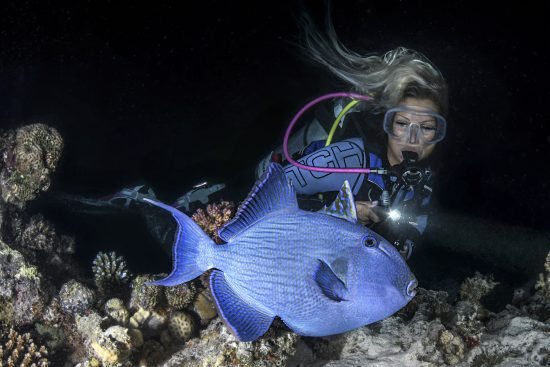
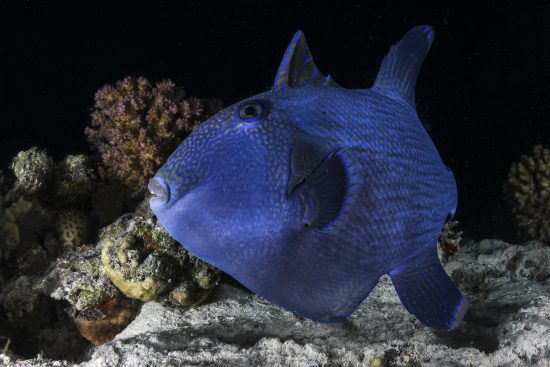
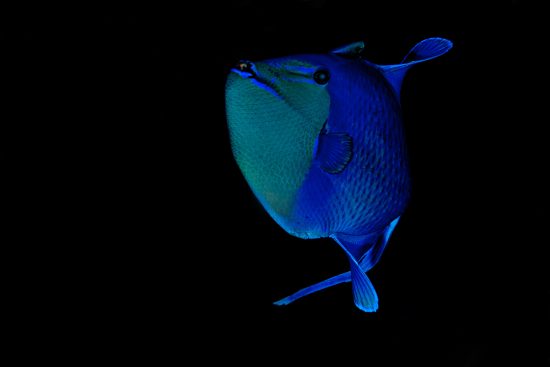
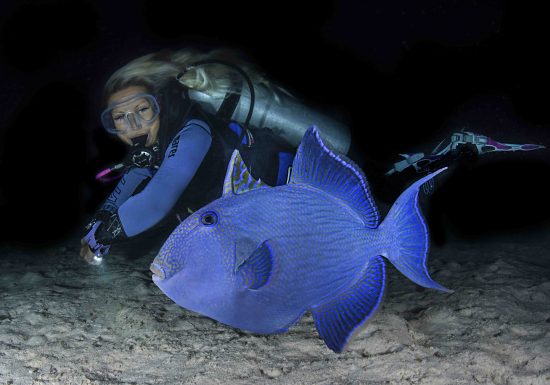
Triggerfish or balistoids (from the family Balistidae) are mostly rhomboid shaped fish, almost circular, with eyes that can rotate independently positioned high up and far back on the head. Some species of triggerfish, such as Stone triggerfish living in the Pacific, can grow to 1m in length. These fish have 2 very distinct sets of dorsal fins which give them their name which comes from the "trigger, " a locking mechanism of the first and second dorsal fins. They can unlock the rigid first dorsal spine by depressing the second dorsal. Apart from deterring predators and looking scary, it can also be used as an anchor mechanism, especially since they like to live in strong current conditions.
The small mouth of a triggerfish hides a very powerful jaw with eight tough teeth which form a beak tough enough to crack hard shelled crustaceans and shellfish or coral branches.
They live within reefs and rock formations where they can easily find all their favourite food. They dig out prey, mainly molluscs, shellfish and crustaceans, sometimes worms, by flapping their fins to get sediment and large particles out of the way and then sandblast the area with water, squirting it from their mouths. They are very messy eaters, which benefits other fish on the reef who clean up their mess. After triggerfish are finished with their food, there are plenty of leftovers for others.
Triggerfish tend to be solitary but meet up with others at selected nesting grounds depending on tides and moon phases. Many males from different species prepare nests for the thousands of eggs deposited there. They make nests by making conical depressions in the sand while waiting for females to arrive. Once they decide on the location of their nests, they have only one mission: to protect. That is how they got their reputation of being aggressive fish. To protect their nests, they often are seen charging and attacking divers who unknowingly encroach on their territory.
Both males and females share taking care of the eggs until they hatch, blowing water on them to keep them well oxygenated. In some species of triggerfish, males maintain a harem of female mates.
As they are attractive looking fish, some species have become threatened in recent times as they are overfished mainly for the aquarium trade. However, they are not happy being stuck in a tank and have been known to bite through tubing and heaters in aquariums with their very impressive bite.
I love watching triggerfish in their natural environment, but with more than 40 species of triggerfish around the world, it is hard to decide on my favourite.
A few that I am particularly fond of are:
Blue triggerfish: These live in the warm waters of the Indo-Pacific, between 22-28°C. They grow to a maximum of 50cm. These powerful swimmers inhabit reefs, often in very strong currents. Their pectoral fins are small, so this fish species steers with their dorsal and anal fins making it very easy for them to manoeuvre using their fins as propellers, a very characteristic swimming style. I'm not sure if it is the red teeth they develop when they mature or the cute grunting sounds they make that makes me like them a lot. It could also be that they can change colour depending on their mood, feeding habits or water quality, from purple to blue and blue-green.
My second favourite species of triggerfish are Titan triggerfish: These live in deep waters down to 50m. They are large and found mostly in lagoons in the Indo-Pacific. They have a length of up to 75cm. They are a diurnal species (active during the day) and feed on the branches of coral, molluscs and crustaceans. They are green with tough scales, yellow or green fins with black tips and have a characteristic lower jaw which is dark grey or purple. In some locations, they can be all yellow. The dark markings around their mouth make them look like they have a moustache. Maybe that is what makes them look very cute.
And last but not least the Yellow-spotted triggerfish: These also like deeper reefs, between 30 and 50m deep, and grow to 55cm. I love their dark colours with characteristic yellow spots and fins with yellow margins. Juveniles are tanned with saddles and lines which they lose when they mature, but they develop amazing looking blue wavy lines all over their bodies. This species doesn't form harems but instead forms monogamous pairs. In this species, the female is the one to be aware of. She will bite holes in your fins and bite through your wetsuit if she feels that you are a threat.
The bite of a triggerfish is not to be taken lightly. It can lead to a painful and dangerous infection due to the Ciguatoxin found in marine algae feeding organisms. So, if you are unfortunate enough to get bitten, please seek medical help.
Written by Bogna Griffin
Photos by Ivana OK and Janez Kranjc
 Ivana and Janez
Ivana and Janez 12th January 2023
12th January 2023